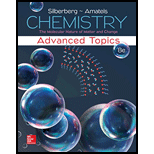
(a)
Interpretation:
The alteration in the pressure has to be mentioned in order to decrease the yield of product.
Concept Introduction:
Le Chatelier principle states that, whenever a change in temperature, pressure or volume is experienced by a system at equilibrium, the system will undergo reactions to cancel that effect and reattain equilibrium.
Changes in pressure have significant effect on the reactions containing gas molecules. When pressure is increased, the system will try to decrease the pressure by reducing the number of gas molecule. That is, the reaction will occur to the direction where the number moles of gases are low. When the pressure is decreased, the reaction will favor in the direction where the number moles of gases are high, so as to increase the pressure.
(b)
Interpretation:
The alteration in the pressure has to be mentioned in order to decrease the yield of product.
Concept Introduction:
Le Chatelier principle states that, whenever a change in temperature, pressure or volume is experienced by a system at equilibrium, the system will undergo reactions to cancel that effect and reattain equilibrium.
Changes in pressure have significant effect on the reactions containing gas molecules. When pressure is increased, the system will try to decrease the pressure by reducing the number of gas molecule. That is, the reaction will occur to the direction where the number moles of gases are low. When the pressure is decreased, the reaction will favor in the direction where the number moles of gases are high, so as to increase the pressure.
(c)
Interpretation:
The alteration in the pressure has to be mentioned in order to decrease the yield of product.
Concept Introduction:
Le Chatelier principle states that, whenever a change in temperature, pressure or volume is experienced by a system at equilibrium, the system will undergo reactions to cancel that effect and reattain equilibrium.
Changes in pressure have significant effect on the reactions containing gas molecules. When pressure is increased, the system will try to decrease the pressure by reducing the number of gas molecule. That is, the reaction will occur to the direction where the number moles of gases are low. When the pressure is decreased, the reaction will favor in the direction where the number moles of gases are high, so as to increase the pressure.
Want to see the full answer?
Check out a sample textbook solution
Chapter 17 Solutions
Student Solutions Manual For Silberberg Chemistry: The Molecular Nature Of Matter And Change With Advanced Topics
- Synthesize 2-Ethyl-3-methyloxirane from dimethyl(propyl)sulfonium iodide using the necessary organic or inorganic reagents. Draw the structures of the compounds.arrow_forwardSynthesize 2-Hydroxy-2-phenylacetonitrile from phenylmethanol using the necessary organic or inorganic reagents. Draw the structures of the compounds.arrow_forwardSynthesize N-Methylcyclohexylamine from cyclohexanol using the necessary organic or inorganic reagents. Draw the structures of the compounds.arrow_forward
- Synthesize N-Methylcyclohexylamine from cyclohexanol using the necessary organic or inorganic reagents. Draw the structures of the compounds.arrow_forwardIf possible, please provide the formula of the compound 3,3-dimethylbut-2-enal.arrow_forwardSynthesize 1,4-dibromobenzene from acetanilide (N-phenylacetamide) using the necessary organic or inorganic reagents. Draw the structures of the compounds.arrow_forward
- Indicate the products obtained by mixing (3-oxo-3-phenylpropyl)triphenylphosphonium bromide with sodium hydride.arrow_forwardWe mix N-ethyl-2-hexanamine with excess methyl iodide and followed by heating with aqueous Ag2O. Indicate the major products obtained.arrow_forwardIndicate the products obtained by mixing acetophenone with iodine and NaOH.arrow_forward
- Indicate the products obtained by mixing 2-Propanone and ethyllithium and performing a subsequent acid hydrolysis.arrow_forwardIndicate the products obtained if (E)-2-butenal and 3-oxo-butanenitrile are mixed with sodium ethoxide in ethanol.arrow_forwardQuestion 3 (4 points), Draw a full arrow-pushing mechanism for the following reaction Please draw all structures clearly. Note that this intramolecular cyclization is analogous to the mechanism for halohydrin formation. COH Br + HBr Brarrow_forward
 ChemistryChemistryISBN:9781305957404Author:Steven S. Zumdahl, Susan A. Zumdahl, Donald J. DeCostePublisher:Cengage Learning
ChemistryChemistryISBN:9781305957404Author:Steven S. Zumdahl, Susan A. Zumdahl, Donald J. DeCostePublisher:Cengage Learning ChemistryChemistryISBN:9781259911156Author:Raymond Chang Dr., Jason Overby ProfessorPublisher:McGraw-Hill Education
ChemistryChemistryISBN:9781259911156Author:Raymond Chang Dr., Jason Overby ProfessorPublisher:McGraw-Hill Education Principles of Instrumental AnalysisChemistryISBN:9781305577213Author:Douglas A. Skoog, F. James Holler, Stanley R. CrouchPublisher:Cengage Learning
Principles of Instrumental AnalysisChemistryISBN:9781305577213Author:Douglas A. Skoog, F. James Holler, Stanley R. CrouchPublisher:Cengage Learning Organic ChemistryChemistryISBN:9780078021558Author:Janice Gorzynski Smith Dr.Publisher:McGraw-Hill Education
Organic ChemistryChemistryISBN:9780078021558Author:Janice Gorzynski Smith Dr.Publisher:McGraw-Hill Education Chemistry: Principles and ReactionsChemistryISBN:9781305079373Author:William L. Masterton, Cecile N. HurleyPublisher:Cengage Learning
Chemistry: Principles and ReactionsChemistryISBN:9781305079373Author:William L. Masterton, Cecile N. HurleyPublisher:Cengage Learning Elementary Principles of Chemical Processes, Bind...ChemistryISBN:9781118431221Author:Richard M. Felder, Ronald W. Rousseau, Lisa G. BullardPublisher:WILEY
Elementary Principles of Chemical Processes, Bind...ChemistryISBN:9781118431221Author:Richard M. Felder, Ronald W. Rousseau, Lisa G. BullardPublisher:WILEY





